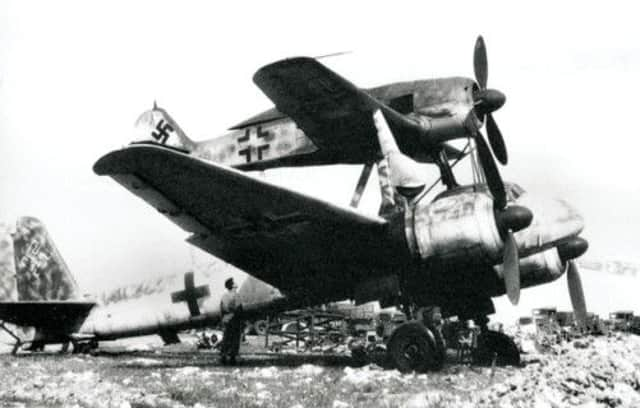Revealed: Nazi bid to blow up fleet off Orkney


But Nazi Luftwaffe chief Hermann Goering was still determined to strike back at the Allies with an incredible plan to attack the famous naval base at Scapa Flow in Orkney, employing a revolutionary new Mistel bomber weapon.
For almost 70 years the plan has been largely forgotten beyond a tiny circle of Luftwaffe officers directly involved in the secret mission. But now aviation historian Robert Forsyth, has uncovered the full story of the amazing Nazi operation and that it may have been sabotaged by its own commanding officer.
Advertisement
Hide AdThe plan was to attack the Royal Navy fleet at berth, inflicting major damage and casualties. But it may have been the fear of Colonel Werner Baumbach, who was to lead the Mistel squadron, that it was little short of a suicide mission that would needlessly cost the lives of his men that may have led him to tip off the British. Minutes before take-off the planes were unexpectedly strafed by RAF fighters and the mission aborted.
Forsyth has now uncovered previously-unpublished documents relating to the mission. “In a revealing post-war testimony [Mistel pilot] Balduin Pauli wrote in a letter to his former comrades: “after the war, when I met Baumbach in Spain, he said the Reichsmarschall desperately needed a success as a matter of prestige so that he could once again show his face to the Fuhrer,” Forsyth said.
However, in Baumbach’s opinion, the letter stated, “the mission was not essential to the war effort and, in all probability, we stood to incur a casualty rate of about 80 per cent. So, using certain channels, he had deliberately betrayed the operation.”’
The operation would have involved the use of the “Mistel” (German for Mistletoe), which was the Nazis’ latest secret weapon and a composite bomber consisting of a Focke Wulf 190 fighter mounted atop a Junkers 88 bomber filled with high explosives. Carrying a devastating warhead containing 1,700 kg of explosives, the Mistel could penetrate several feet of steel and sink even the biggest battleships.
Forsyth said: “In January, 1945, Hermann Goering sought desperately for a high-profile mission opportunity with which he could salvage the Luftwaffe’s reputation.
“With the Mistel, he had the opportunity to launch an attack on the Royal Navy’s vital northern base at Scapa Flow The code name conjured up for the proposed operation was “Dragon’s Lair”.’
Advertisement
Hide Ad‘The concept was for the pilot of the upper fighter component to fly both aircraft to the target, whereupon the lower component would be released, hopefully on course to achieve a direct hit.” Some of Germany’s most-experienced pilots were assembled amid intense secrecy at a Danish airfield in the small town of Tirstrup in February 1945 to prepare for the mission. One of them broke his 70-year silence to tell Forsyth about the plan.
“As far as the Scapa Flow attack plan was concerned,” recalled Rudi Riedl, then a young sergeant in the Luftwaffe, “we received only one proper briefing, which took place in a large room of a country house near the airfield, in which was a large map of the Scapa Flow area. We had a specially built model of the harbour on which were laid scale models of all the ships known to be there.
Advertisement
Hide Ad“Each pilot was assigned an individual target since we received regular reconnaissance updates on British shipping movements. I knew exactly where my target ship was anchored.
“Once the attack had been made, the plan was for our Fw190s to make for Stavangar in Norway, which was the closest point for a safe landing.”
He added: “We all wanted the mission to work, because we knew we would be decorated when we got back – there was talk of the Knight’s Cross.” But on the day of the planned attack, 14 February, just as the pilots were preparing to board their bombers, the airfield was strafed by two RAF Mosquito fighters, which destroyed most of the aircraft on the ground.
Riedl recalled: “As we were about to climb aboard our aircraft for our ride to hell, we heard the sounds of aircraft engines. I gazed upwards and saw two twin-engined fighters approach over the treetops in the distance. Then there was one hell of a commotion!”
With the squadron reduced to just a couple of serviceable aircraft and the element of surprise gone, Goering reluctantly shelved the plan.
“On 16 February the war diary of the Luftwaffe High Command records that: ‘The Reichsmarschall has decided that Operation Dragon’s Lair cannot be carried out for the time being’,” Forsyth revealed.